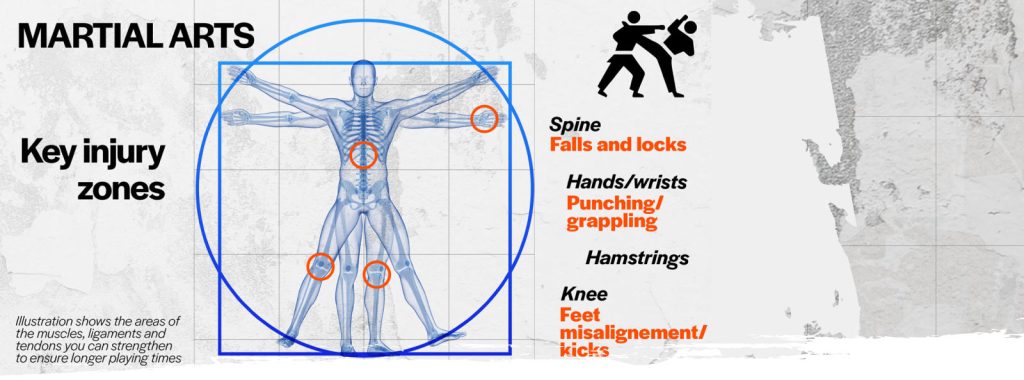
If you’re a martial arts fiend, you are trained to react to external threats without conscious thinking. Karate, taekwondo and judo aim to unify body and mind. Add in MMA, and you have four full contact fighting sports where, loosely speaking, you win by disabling your opponent …
For example, the reported injury rate in judo is an astounding 79%*, including light and serious injuries. In karate, you’re most likely to report head and neck bruisings and lacerations**. Taekwondo specialise in head-height kicks (that really says it all) and MMA is considered one of the most brutal sports ever.
Enough scaremongering! If you are reading this, you already know all of it and your love for martial arts can’t be affected (nor it is my intention to), and you have my utmost respect for it.
I’ll leave the combat skills to you, but I would like to guide you through prevention for those injuries which are not provoked by impacts, but by other physiological/biomechanical forces.
Spine
Imagine your spine (or vertebral column) like a pile of cylinders (It’s 31 of them) with soft discs in between. All together they can twist, bend and fold at impressive angles, but if you take a single pair… not so much. If that pair of cylinders (or vertebrae) is strained, the joint that connects them is going to be damaged. Severe spinal injuries are relatively rare, but the constant and repeated heavy landings, the lifting, stretching and twisting will very likely cause back pain and perhaps slipped discs in some cases. This is more likely to happen in judo with all the locks.
Knee
Martial artists often report unspecified knee pains. When fighting all limbs move super-fast in every direction, and perhaps sometimes not perfectly controlled. It is not the leg that kicks which is the one at risk! Sudden changes of direction, jumps and twists can injure the grounded leg while the other leg is raised. All your mass is on one side, effectively doubling the effort of the knee. Plus, if your feet normally don’t align the way they should (out/in-toeing) they will transmit tough torsional forces on your knees.
Hands/wrists
Punching, parrying, grappling… and more! Martial arts put your hands and wrists to the test every time you train or fight. Your wrists are a delicate mosaic of bones. This allows a magnificent range of motion, in exchange for some fragility. The most common effects of a misplaced punch are “boxer’s fracture” and finger dislocation). There is also the chance of carpal instability, particularly in judo: this occurs when the “mosaic” of bones loses its natural alignment, mixing those bones up a bit. They somehow keep working, but there is pain and inflammation.
Hamstrings
Karate and MMA involve a great deal of kicks. Often, they are high kicks aimed to hit the opponent’s face, so a tonne of hamstring work is required. If there is not enough flexibility, or hamstrings are tired/debilitated for any reason, a strain may occur.
Below I’ve selected ideal drills to prepare you for all these risks. But of course, the uniqueness of martial arts means that prevention is also achieved when you perfect techniques, perfect your mental skills, select correct equipment and by not undertaking a fight if not ready. It is a branch of sport that requires courage, passion and wisdom.
EXERCICES
Make your spine strong and flexible
Position yourself in a quadruped position, hands below your shoulders and knees below your hips. Then push your bum back and at the same time “thread the needle” by rotating and pushing one arm as far out as far as possible, until the back of your shoulder touches the ground. Hold it for a minute, and contract your abs as if someone was punching you in the belly. Repeat 3 times each side.

Build solid muscles around your knees
From the floor, point your toes out and relax your chest. Start by squeezing one quad (thigh) and your abs very very hard (to stop lower back from overarching). Then lift up that same leg. Go as far up as possible WITHOUT bending your knee. Don’t worry if it is a short movement: it’s perfectly normal. Hold it for 40 seconds, repeat 3 times each leg.

Get your wrists ready for actions
Prayer stretch
put your hands together in a “prayer” position, at a comfortable height. Then bring them as far low as you can without losing the full palm contact. Stay there for 30 seconds and repeat 5 times.

Knuckles plank
This is the same as a regular straight arms plank, but your hand is closed into a fist towards the ground. Make sure that your wrist is in line and stable. If it is too much to start with, start from your knees. Don’t be a hero: start on a soft surface, and only hold it for as long as you feel mild discomfort, but not pain. Build it up slowly through the weeks.

Prepare hamstring for flying kicks
Stretch
One knee on is on the ground, supporting most of your weight, and the other leg is straight out in what should be an angle as close as 90 degrees as possible (don’t worry if it isn’t). Then try to reach with one or both hands towards the toes of the straight leg. If you can’t reach, grab your ankle or knee, but hold on to a fixed point for 45 second. Repeat 3 times each leg.

Hamstrings curls
The name of the hamstrings is bicep femoris – basically it’s the bicep of your leg. Let’s do some curls to make them stronger! Lie on your belly and hold a water bottle tight (very tight) between your feet. Then raise both legs leaving your knees on the ground. Control the movement, go as close to your bum as you can but don’t let the bottle touch the ground during the set. Perform 4 sets of 15 reps.

References
*Akoto, R., Lambert C., Balke M., Bouillon B., Frosch K., Hoher J. (2017) ‘Epidemiology of injuries in judo: a cross-sectional survery of severe injuries based on time loss and reduction in sporting level.’ British Journal of Sports Medicine, 0, 1-8.
**Lystad, R. P., Augustovicova D., Harris G., Beskin K., Arriaza R. (2020) ‘Epidemiology of injuries in Olympic-style karate competitions: systematic review and meta-analysis.’ British Journal of Sports Medicine, 54, 976-983.
***Altarriba-Bartes A., Drobnic F., Til L., Malliaropoulos N., Montoro J. B., Irurtia A. (2014) ‘Epidemiology of Injuries in elite taekwondo athletes: two Olympic periods cross-sectional retrospective study.’ British Medical Journal – Open Access.
James L. P. (2014) ‘Injury prevention strategies for Mixed Martial Arts.’ National Strength and Conditioning Association, 36(5), 88-95
Further reading
Encyclopaedia Britannica: Martial Arts. Available from: https://www.britannica.com/sports/martial-art [28/12/2020]
Encyclopaedia Britannica: Mixed Martial Arts. Available from: https://www.britannica.com/sports/mixed-martial-arts [28/12/2020]






